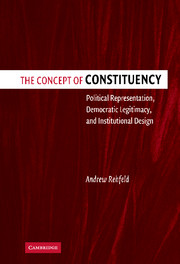 The Concept of Constituency
The Concept of Constituency Book contents
- Frontmatter
- Contents
- List of Tables
- Preface
- PART I CONCEPTUAL FOUNDATIONS: ON CONSTITUENCY AND POLITICAL REPRESENTATION
- PART II HISTORICAL JUSTIFICATIONS: ON THE ORIGINS OF TERRITORIAL CONSTITUENCIES IN THE UNITED STATES
- 3 Justifications and the Use of History
- 4 The English and Colonial Origins of Territorial Constituencies in the United States
- 5 Origins, Part 1: What Territorial Representation Was Not Meant To Do
- 6 Origins, Part 2: Territorial Representation as an Enabler of Democratic Values
- PART III NORMATIVE APPLICATIONS: ON LEGITIMATE REPRESENTATION AND INSTITUTIONAL DESIGN
- Index
3 - Justifications and the Use of History
Published online by Cambridge University Press: 27 July 2009
- Frontmatter
- Contents
- List of Tables
- Preface
- PART I CONCEPTUAL FOUNDATIONS: ON CONSTITUENCY AND POLITICAL REPRESENTATION
- PART II HISTORICAL JUSTIFICATIONS: ON THE ORIGINS OF TERRITORIAL CONSTITUENCIES IN THE UNITED STATES
- 3 Justifications and the Use of History
- 4 The English and Colonial Origins of Territorial Constituencies in the United States
- 5 Origins, Part 1: What Territorial Representation Was Not Meant To Do
- 6 Origins, Part 2: Territorial Representation as an Enabler of Democratic Values
- PART III NORMATIVE APPLICATIONS: ON LEGITIMATE REPRESENTATION AND INSTITUTIONAL DESIGN
- Index
Summary
SILENCE OF THE LAND
On March 17, 1999, Representative Melvin Watt (D-NC) introduced House bill 1173. “The States' Choice of Voting Systems Act (VSA)” stipulated that:
there may be established by law a number of districts equal to the number of the representatives into which such State is so entitled and representatives may be elected only from single member districts so established, or
such State may establish a number of districts for election of Representatives that is less than the number of Representatives to which the state is entitled and Representatives may be elected from single member districts, multi member districts, or a combination of single-member and multi-member districts if that state uses a system that meets the constitutional standard that each voter should have equal voting power and does not violate the Voting Rights Act of 1965 (42 U.S.C. 1973 et seq.).
In plain language, the bill would have allowed states to use a wide variety of electoral systems to elect representatives to the House. The VSA would have returned to the states their authority over elections where it had been in the period just after the founding of the United States. Article 1, Section 4 of the U.S. Constitution establishes that each state has the right to choose its own electoral system provided that “Congress may at any time by Law make or alter such Regulations….” Congress has acted a number of times, most recently in reestablishing single-member, territorial districts in 1967.
- Type
- Chapter
- Information
- The Concept of ConstituencyPolitical Representation, Democratic Legitimacy, and Institutional Design, pp. 55 - 68Publisher: Cambridge University PressPrint publication year: 2005
